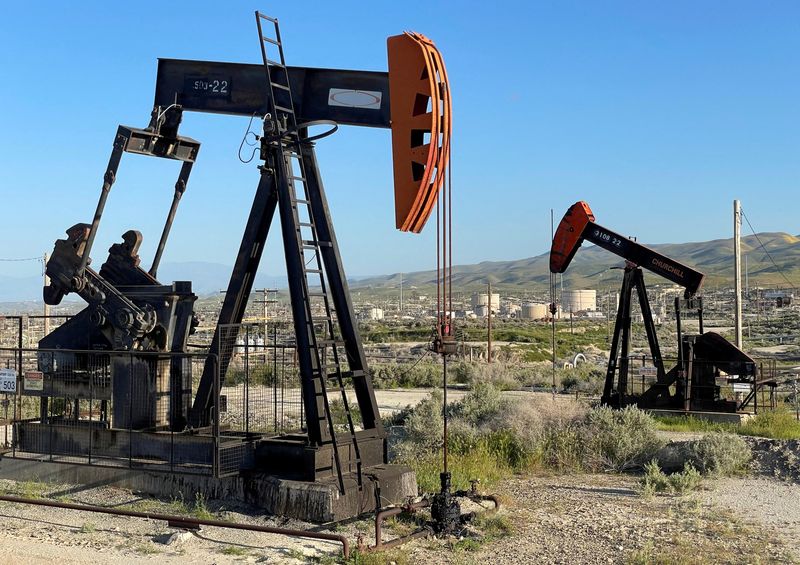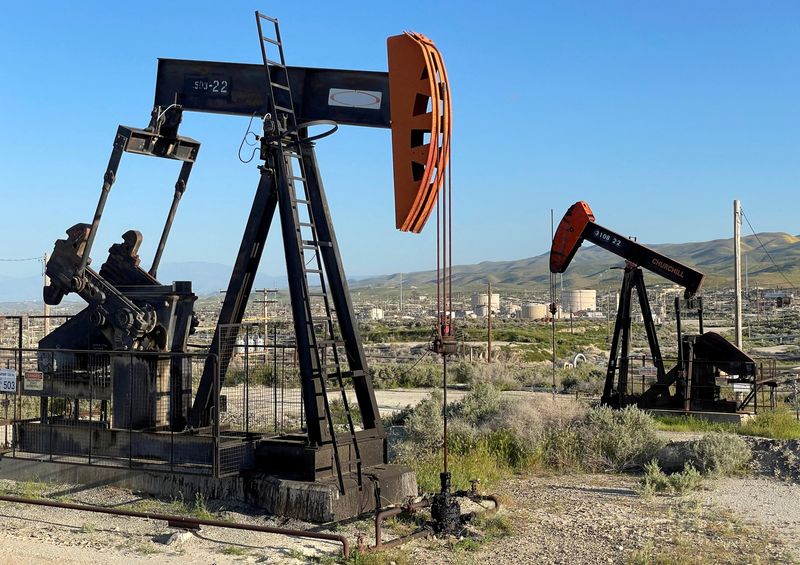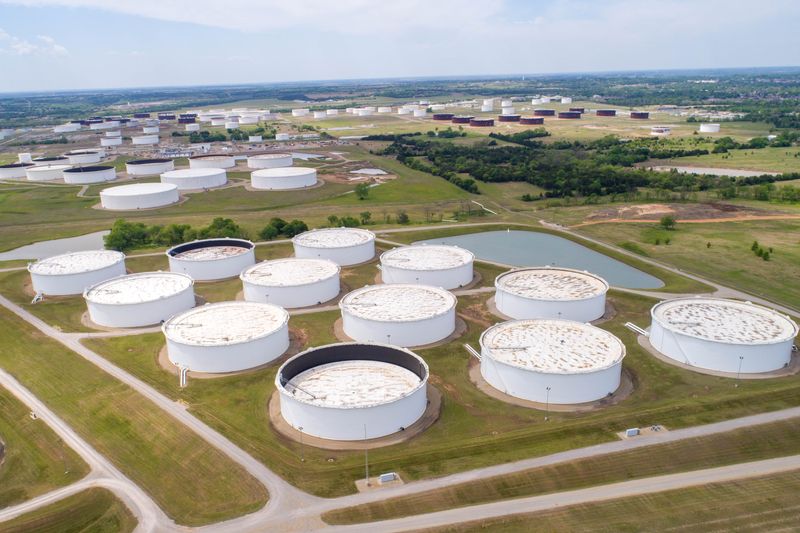Commodities
US finalizes higher fees for oil and gas companies on federal lands

By Nichola Groom
(Reuters) -President Joe Biden’s administration on Friday finalized a range of reforms designed to boost returns and address environmental harms from drilling on public lands, a move that will increase fees for oil and gas companies that operate there.
The new rules follow years of criticism from green and taxpayer groups that federal oil and gas development was not benefiting the public. Many of the changes by the Interior Department’s Bureau of Land Management (BLM) formalize provisions in Biden’s landmark climate change law, the 2022 Inflation Reduction Act (IRA).
Under the new policy, oil and gas companies will pay higher bonding rates to cover the cost of plugging abandoned oil and gas wells as well as increased lease rents, minimum auction bids and royalty rates for the fuels they extract. The rules also limit drilling in sensitive wildlife and cultural areas.
“These are the most significant reforms to the federal oil and gas leasing program in decades, and the will cut wasteful speculation, increase returns for the public, and protect taxpayers from being saddled with the costs of environmental cleanups,” Interior Secretary Deb Haaland said in a statement.
About 10% of the nation’s oil and gas comes from drilling on federally owned land. An oil and gas industry trade group warned that higher costs to extract fuels from federal lands could boost U.S. reliance on foreign supplies.
“Overly burdensome land management regulations will put this critical energy supply at risk,” American Petroleum Institute Vice President of Upstream Policy Holly Hopkins said in a statement.
Biden vowed during his 2020 election campaign to end federal oil and gas leasing as part of his agenda to combat climate change. But the IRA effectively guaranteed continued drilling rights auctions on federal lands for at least another decade as a concession to the powerful fossil fuel lobby.
Several environmental and taxpayer organizations praised the reforms, saying they would tamp down on speculation and hold oil and gas companies accountable for cleaning up old wells.
One group, Friends of the Earth, said the rules failed to address the climate impact of fuel extraction on public lands.
“While we support BLM’s steps to curb financial giveaways to Big Oil, this rule failes to confront the massive tide of climate emissions stemming from its leasing program,” Nicole Ghio, senior fossil fuels program manager at Friends of the Earth, said in a statement.
Drillers are required to pay upfront bonds to cover future cleanups if they fail, and a 2019 government analysis found bonding levels were inadequate.

Minimum lease bonds will soar to $150,000 under the new rules from $10,000 — a level unchanged since 1960.
Royalty rates will rise to 16.67% from 12.5%, and the minimum amount companies can bid at oil and gas auctions will increase to $10 an acre from $2. The rental rate for a 10-year lease will double to $3 an acre for the first two years, eventually rising to $15 per acre in the final years. The fees can be adjusted for inflation after 10 years.
Commodities
Gold prices sink below $2,300 as markets brace for hawkish Fed

Investing.com– Gold prices fell in Asian trade on Wednesday, extending steep overnight losses that saw the yellow metal slide past a key support level as markets braced for potentially hawkish signals from the Federal Reserve later in the day.
The yellow metal fell further from record highs hit in April as diminished safe haven demand, amid some de-escalation in global geopolitical tensions, left it vulnerable to headwinds from interest rates.
fell 0.1% to $2,285.19 an ounce, while expiring in June fell 0.3% to $2,295.25 an ounce by 23:50 ET (03:50 GMT). Spot prices fell below the closely-watched $2,300 an ounce level on Tuesday, leaving the yellow metal open to more losses before more cues on U.S. interest rates.
Fed meeting awaited, Powell to wax hawkish
Focus was now squarely on the conclusion of a two-day later on Wednesday, where the central bank is set to keep rates unchanged.
But Fed Chair Jerome Powell is widely expected to offer a hawkish outlook, especially after a string of hotter-than-expected inflation readings. A stronger-than-expected reading on the , for the first quarter, furthered this notion on Tuesday.
Strong inflation readings saw traders steadily price out expectations of early rate cuts by the Fed. The central bank is now only expected to begin cutting rates by September, if at all.
Higher-for-longer interest rates bode poorly for gold, given that they increase the opportunity cost of investing in the yellow metal. Dwindling expectations of rate cuts dragged gold prices down from record highs over the past two weeks.
remove ads
.
Other precious metals also fell on Wednesday, as the dollar shot up to near six-month highs. fell 0.2% to $943.95 an ounce, while fell 0.2% to $26.598 an ounce.
Copper prices fall from two-year highs after stellar April
Among industrial metals, copper prices fell from two-year highs amid pressure from a stronger dollar, while stellar gains through April also made for some profit-taking.
on the London Metal Exchange fell 0.8% to $9,910.0 a ton, while fell 0.3% to $4.5285 a pound.
Both contracts surged between 14% and 16% in April on expectations of tighter supplies, amid more sanction on Russia and production cuts by major Chinese refiners.
But fears of slowing economic growth- especially as interest rates remain higher for longer- may chip away at copper in the near-term.
Commodities
Oil falls for a third day on Middle East ceasefire hopes

By Alex Lawler and Deep Kaushik Vakil
LONDON (Reuters) -Oil fell more than 1% on Wednesday, losing ground for a third straight session on hopes of a ceasefire agreement in the Middle East and by rising crude inventories and production in top consumer the United States.
Expectations that a ceasefire agreement between Israel and Hamas could be in sight have grown following a renewed push led by Egypt, even as Israeli Prime Minister Benjamin Netanyahu has vowed to go ahead with a long-promised assault on Rafah.
futures for July were down $1.24, or 1.4%, to $85.09 a barrel by 1145 GMT, having hit $84.78, their lowest since March 15.
U.S. West Texas Intermediate crude futures for June were down $1.33, or 1.6%, to $80.60, after touching their lowest since March 21.
“The crude market is weighed down by continued hopes for a ceasefire,” said Ole Hansen of Saxo Bank.
“In addition, stubborn U.S. inflation has further reduced rate cut expectations.”
U.S. Federal Reserve officials are concluding their latest two-day policy meeting on Wednesday and are expected to hold interest rates steady. A rate cut would act as a boost to economic growth and fuel demand.
“Continued signs of inflation also raised concerns about demand for crude oil. This comes ahead of the U.S. driving season, where demand for gasoline rises strongly,” ANZ analysts said in a report on Wednesday.
Further weighing on prices were separate reports that inventories rose and production increased.
remove ads
.
U.S. crude inventories rose 4.906 million barrels in the week ended April 26, according to market sources citing American Petroleum Institute figures, which defied expectations for a decline of 1.1 million barrels.
Traders will be waiting to see if official data from the Energy Information Administration (EIA) at 1430 GMT confirms the trend.
On Tuesday, the EIA said U.S. production rose to 13.15 million barrels per day (bpd) in February from 12.58 million bpd in January, its biggest monthly increase in about 3-1/2 years.
Commodities
Oil prices sink on surprise US inventory build; Middle East peace talks eyed

Investing.com– Oil prices fell sharply Wednesday, extending recent losses as an unexpected build in U.S. stockpiles and strong crude production sparked doubts over tight supply conditions ahead of the Fed meeting.
At 08:25 ET (12:25 GMT), fell 1.4% to $85.15 a barrel, while fell 1.6% to $80.61 a barrel, dropping to their lowest levels since mid-March.
U.S. inventory build, strong output weighs
Data from the American Petroleum Institute, released on Tuesday, indicated that U.S. grew by 4.9 million barrels in the week to April 26, a far greater build than the increase of 1.5 million barrels expected.
While gasoline and distillate stockpiles shrank, if this rise in overall inventories id confirmed by , due later in the session, it would suggest that oil supplies were not as tight as initially expected in the world’s biggest fuel consumer.
This notion was reinforced by separate data showing U.S. domestic crude output rose to 13.15 million barrels per day in February from 12.58 million barrels in January, its biggest jump since October. The rise also saw U.S. production come back in sight of record highs.
This spurred doubts over just how tight global crude markets would be in the coming months, given that U.S. output remains robust and the country’s oil markets remain well supplied.
Fed fears in play, dollar strength weighs
Markets were also on edge ahead of the conclusion of a two-day policy meeting of the Federal Reserve later in the day.
remove ads
.
While the central bank is widely expected to , Fed Chair Jerome Powell is likely to strike a hawkish note following a series of strong inflation readings.
Expectations of higher-for-longer U.S. interest rates saw the dollar rise sharply this week, which also weighed on oil prices, with prolonged exposure to elevated interest rates likely to weigh on economic activity by the world’s largest consumer.
Middle East peace talks
A potential ceasefire between Israel and Hamas could also further downplay expectations of tighter markets, as it would lower the risks of supply disruptions in the key oil-rich Middle East.
Expectations that a ceasefire agreement between Israel and Hamas could be in sight have grown following a renewed push led by Egypt.
“The geopolitical risk premium continues to fade as tensions between Israel and Iran have eased. There are also some hopes for a potential ceasefire between Israel and Hamas,” said analysts at ING, in a note.
(Ambar Warrick contributed to this article.)

 Forex2 years ago
Forex2 years agoForex Today: the dollar is gaining strength amid gloomy sentiment at the start of the Fed’s week

 Forex2 years ago
Forex2 years agoHow is the Australian dollar doing today?

 Forex1 year ago
Forex1 year agoUnbiased review of Pocket Option broker

 Forex2 years ago
Forex2 years agoDollar to pound sterling exchange rate today: Pound plummeted to its lowest since 1985

 Cryptocurrency2 years ago
Cryptocurrency2 years agoWhat happened in the crypto market – current events today

 World2 years ago
World2 years agoWhy are modern video games an art form?

 Stock Markets2 years ago
Stock Markets2 years agoMorgan Stanley: bear market rally to continue

 Economy2 years ago
Economy2 years agoCrude oil tankers double in price due to EU anti-Russian sanctions

































